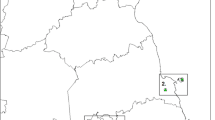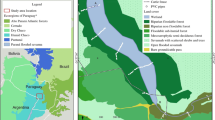Abstract
We studied the use of polyvinil chloride pipes (PVC pipes) by frogs as artificial shelters in a Coastal Plain forest in the Vale Natural Reserve, north of Espírito Santo state, southeastern Brazil from June 2015 to May 2016. We used 14 plots distributed in the Coastal Plain Forest following the RAPELD methodology of sampling. The frogs were sampled in transects along the plots, using the active search method, with visual and auditory sampling. We recorded two species of frogs (Aparasphenodon brunoi and Scinax argyreornatus) using PVC pipes as shelters in the plots in the Forest. Of the 468 PVC pipes established along plots, 38 of them (8.1%) were used as shelter by the frogs. For both frog species, about 33% of microhabitats used in the forest were the interior of PVC pipes. We concluded that the PVC pipes might constitute artificial shelters for at least two of the frog species living in the community of the Coastal Plain Forest, potentially being of relevance in conservation programs. In altered areas and those in which there has been the loss of types of microhabitats, the addition of these PVC pipes as artificial shelters may represent additional and complementary microhabitats to keep or increase the population stocks of arboreal and semi-arboreal frog species and having a size that allow them entering the shelter. These artificial shelters can play an important role in conservation of these frogs in fragmented areas where the availability of the microhabitats of these frog species were locally reduced.



Similar content being viewed by others
References
Arce AM, Aguilar-Dávila W, Sosa-Cordero E, Caddy JF (1997) Artificial shelters (casitas) as habitats for juvenile spiny lobsters Panulirus argus in the Mexican Caribbean. Marin Ecol Prog Ser 158:217–224
Bell TP (2009) A novel technique for monitoring highly cryptic lizard species in forests. Herpetol Conserv Biol 4:415–425
Boquimpani-Freitas L, Marra RV, Van Sluys M, Rocha CFD (2007) Temporal niche of acoustic activity in anurans: interspecific and seasonal variation in a neotropical assemblage from South-Eastern Brazil. Amphibia-Reptilia 28:269–276
Boughton RG, Staiger J, Franz R (2000) Use of PVC pipe refugia as a sampling technique for hylid treefrogs. Am Midl Nat 144:168–177
Campbell KR, Campbell TS, Johnson SA (2010) The use of PVC pipe refugia to evaluate spatial and temporal distributions of native and introduced treefrogs. Florida Scientist 73:78–78
Ciechanowski M (2005) Utilization of artificial shelters by bats (Chiroptera) in three different types of forest. Fol Zool 54(1–2):31–37
Crump ML, Scott NJ Jr (1994) Visual encounter surveys. In: Heyer WR, Donnelly RW, McDiarmid MA, Hayek LAC, Foster MS (eds) Measuring and monitoring biological diversity: standard methods for amphibians. Smithsonian Institution Press, Washington, pp. 84–92
Donnelly MA, Baber MJ, Farrell CJ (2001) The amphibians and reptiles of the Kissimmee River II: patterns of abundance and occurrence in hammocks and pastures. Herpetol Nat Hist 8:171–179
Ferreira E, Rocha RG, Malvasio A, Fonseca C (2012) Pipe refuge occupancy by herpetofauna in the Amazonia/Cerrado ecotone. Herpetol Journ 22:59–62
Fordham DA, Watts MJ, Delean S, Brook BW, Heard LMB, Bull CM (2012) Managed relocation as an adaptation strategy for mitigating climate change threats to the persistence of an endangered lizard. Glob Change Biol 18:2743–2755
Garay I, Rizzini MC (2004) A Floresta Atlântica de Tabuleiros: Diversidade Funcional da Cobertura Arbórea. Vozes, Petrópolis
Glorioso BM, Waddle JH (2014) A review of pipe and bamboo artificial refugia as sampling tools in anuran studies. Herpetol Conserv Biol 9:609–625
Hampton P (2007) A comparison of the success of artificial cover types for capturing amphibians and reptiles. Amphibia-Reptilia 28:433–437
Hodge S, Vink CJ, Banks JC, Bowie MH (2007) The use of tree-mounted artificial shelters to investigate arboreal spider communities in New Zealand nature reserves. J Arachn 35(1):129–136
Mackenzie DI, Nichols J, Royle J, Pollock K, Bailey L, Hines J (2006) Occupancy estimation and modeling: inferring patterns and dynamics of species occurrence. Elsevier Publishing, San Diego
Magnusson WE, Lima AP, Luizão R, Luizão F, Costa FRC, Castilho CV, Kinupp EVF (2005) RAPELD: a modification of the gentry method for biodiversity surveys in long-term ecological research sites. Biota Neot 5:1–6
Maguire GS, Duivenvoorden AK, Weston MA, Adams R (2011) Provision of artificial shelter on beaches is associated with improved shorebird fledging success. Bird Conserv Intern 21:172–185
Milne T, Bull CM, Hutchinson MN (2003) Fitness of the endangered pygmy blue tongue lizard Tiliqua adelaidensis in artificial burrows. J Herpetol 37:762–765
Ministério do Meio Ambiente (2000) Avaliação e Ações Prioritárias para a Conservação da Biodiversidade da Mata Atlântica e Campos Sulinos. MMA/SBF, Brasília
Myers CH, Eigner L, Harris JA, Hilman R, Johnson MD, Kalinowski R, Muri JJ, Reyes M, Tucci LE (2007) A comparison of ground-based and treebased polyvinyl chloride pipe refugia for capturing Pseudacris regilla in northwestern California. Northw Nat 88:147–154
Peixoto AL, Silva IM, Pereira OJ, Simonelli M, Jesus RM, Rolim SG (2008) Tabuleiro forests north of the Rio Doce: their representation in the Vale do Rio Doce natural reserve, Espírito Santo, Brazil. Memoirs of the New York Botanical Garden 100:313–348
Silva FR, Rossa-Feres DC (2007) Uso de fragmentos florestais por anuros (Amphibia) de área aberta na região noroeste do Estado de São Paulo (The use of forest fragments by open-area anurans (Amphibia) in northwestern São Paulo State, Brazil). Biota Neot 7:141–147
Stewart MM, Pough FH (1983) Population density of tropical forest frogs: relation to retreat sites. Science 221:570–572
Stumpel AHP, Van Der Werf DC (2012) Reptile habitat preference in heathland: implications for heathland management. Herpetol J 22:179–182
Zacharow M, Barichivich WJ, Dodd CK Jr (2003) Using ground-placed PVC pipes to monitor hylid treefrogs: capture biases. Southeast Nat 2:575–590
Acknowledgements
This study is portion of the results of the “Programa de Pesquisas em Biodiversidade da Mata Atlântica (PPBio Mata Atlântica Program)” of Ministério do Meio Ambiente do Brasil (MMA) and was supported by Conselho Nacional de Desenvolvimento Científico e Tecnológico (CNPq) (Process No. 457458/212-7). The authors benefitted from grants provided to Helena Godoy Bergallo (process 307715/2009-4) and to Carlos Frederico Duarte Rocha (304791/2010-5; 470265/2010-8; 302974/2015-6) from Conselho Nacional do Desenvolvimento Científico e Tecnológico (CNPq) and through “Cientistas do Nosso Estado” Program from FAPERJ to Carlos Frederico Duarte Rocha (process No. E-26/102.765.2012 E-26/202.920.2015) and to Helena Godoy Bergallo (process E-26.103.016.2011). Juliane Pereira-Ribeiro and Átilla Colombo Ferreguetti received master and PhD fellowships from Coordenação de Aperfeiçoamento de Pessoal de Nível Superior. The Instituto Chico Mendes de Conservação da Biodiversidade (ICMBio) provided the permit for the development of the study (No. 46327-4) and The Vale Natural Reserve for the Research in the Reserve.
Author information
Authors and Affiliations
Corresponding author
Rights and permissions
About this article
Cite this article
Pereira-Ribeiro, J., Ferreguetti, Á.C., Bergallo, H.G. et al. Use of polyvinyl chloride pipes (PVC) as potential artificial shelters for amphibians in a coastal plain forest of southeastern Brazil. J Coast Conserv 21, 327–331 (2017). https://doi.org/10.1007/s11852-016-0480-6
Received:
Revised:
Accepted:
Published:
Issue Date:
DOI: https://doi.org/10.1007/s11852-016-0480-6




